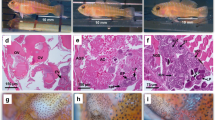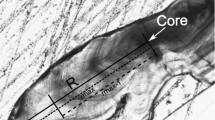Abstract
Social control of sex change occurs in a variety of hermaphroditic fishes; upon removal of the dominant individual, the largest individual of the opposite sex typically changes sex and acquires mating priority with the remaining members of the social group. Social control may allow a phenotypically plastic response to social situations that convey cues about the relative advantages of functioning as one sex or the other, and should be advantageous in highly heterogeneous habitats such as coral reefs. Parrotfishes (family Scaridae) are dominant members of herbivorous coral reef fish assemblages, and numerous histological examinations of gonads have demonstrated the hermaphroditic life history of many species in the family. However, social control of sex change has never been conclusively demonstrated in the parrotfishes. To test a new version of the size-advantage model for sex change, we conducted removal experiments of dominant male bucktooth parrotfish, Sparisoma radians, in St. Croix, U.S. Virgin Islands. A total of seven females from five different reefs changed sex following removals, clearly demonstrating social control of sex change. In addition, all but one of those individuals changing sex were smaller than the largest females remaining in the harems, and this contrasts with nearly all previous studies of sex change in fishes. Sex change proceeds via a novel sequence of events when compared with previous studies. Rather than behavioral sex change preceding morphological sex change, the appearance of male coloration is followed by the development of male behavior that is fully expressed approximately 20 days after removal. We show how differing arrival rates of bachelor males at our study sites may facilitate alternative contexts of sex change, with sex change occurring within social groups in some locations and with bachelor males filling harem vacancies in other locations. Alternative contexts of sex change further illustrate the astonishing phenotypic plasticity in the social and mating behavior of parrotfishes.
Similar content being viewed by others
References
Aldenhoven, J.M. 1986. Different reproductive strategies in a sex-changing coral reef fish Centropyge bicolor (Pomacanthidae). Aust. J. Marine Freshw. Res. 37: 353-360.
Archer, J. 1987. The Behavioural Biology of Aggression. Cambridge University Press, Cambridge. 257 pp.
Balthazart, J. 1983. Hormonal correlates of behavior. Avian Biol. 7: 221-365.
Bellwood, D.R. 1995. Direct estimate of bioerosion by two parrotfish species, Chlorurus gibbus and C. sordidus, on the Great Barrier Reef, Australia. Mar. Biol. 121: 419-429.
Brantley, R.K., J.C. Wingfield & A.H. Bass. 1993. Sex steroid levels in Porichthys notatus, a fish with alternative reproductive tactics, and a review of the hormonal bases for male dimorphism among teleost fishes. Hormones Behav. 27: 332-347.
Cardwell, J.R. & N.R. Liley. 1991a. Androgen control of social status in males of a wild population of stoplight parrotfish, Sparisoma viride (Scaridae). Hormones Behav. 25: 1-18.
Cardwell, J.R. & N.R. Liley. 1991b. Hormonal control of sex and color change in the stoplight parrotfish, Sparisoma viride. General Comp. Endocrinol. 83: 7-20.
Charnov, E.L. 1982. The Theory of Sex Allocation. Princeton University Press, Princeton. 355 pp.
Choat, J.H. 1991. The biology of herbivorous fishes on coral reefs. pp. 120-155.In: P.F. Sale (ed.) The Ecology of Fishes on Coral Reefs, Academic press, San Diego.
Choat, J.H. & D.R. Robertson. 1975. Protogynous hermaphroditism in fishes of the family Scaridae. pp. 263-283. In: R. Reinboth (ed.) Intersexuality in the Animal Kingdom, Springer-Verlag, Heidelberg.
Clavijo, I.E. 1982. Distribution, reproductive biology, and social structure of the redband parrotfish, Sparisoma aurofrenatum Valenciennes. Ph.D. dissertation, University of Puerto Rico, Mayaguez. 151 pp.
Cole, K.S. 1983. Protogynous hermaphroditism in a temperate zone territorial marine goby, Coryphopterus nicholsi. Copeia 3: 809-812.
Cole, K.S. & D.Y. Shapiro. 1995. Social facilitation and sensory mediation of adult sex change in a cryptic, benthic marine goby. J. Exp. Marine Biol. Ecol. 186: 65-75.
Colin, P.L. & L.J. Bell. 1991. Aspects of the spawning of labrid and scarid fishes (Pisces: Labroidei) at Enewetak Atoll, Marshall Islands with notes from other families. Environ. Biol. Fish. 31: 229-260.
Dubin, R.E. 1981. Social behavior and ecology of some Caribbean parrotfish (Scaridae). Ph.D. dissertation, University of Alberta, Edmonton. 285 pp.
Farm, B.P. 1993. Territory dynamics in the bucktooth parrot-fish (Sparisoma radians). Ph.D. dissertation, University of Minnesota, St. Paul. 206 pp.
Fishelson, L. 1970. Protogynous sex reversal in the fish Anthias squamipinnis (Teleostei, Anthiidae) regulated by the presence or absence of a male fish. Nature 227: 90-91.
Francis, R.C. 1992. Sexual liability in teleosts: Developmental factors. Quart. Rev. Biol. 67: 1-18.
Fricke, H. & S. Fricke. 1977. Monogamy and sex change by aggressive dominance in coral reef fish. Nature 266: 830-832.
Ghiselin, M.T. 1969. The evolution of hermaphroditism among animals. Quart. Rev. Biol. 44: 189-208.
Gladfelter, W.B. & E.H. Gladfelter. 1978. Fish community structure as a function of habitat structure on West Indian patch reefs. Rev. Biol. Trop. 26(Suppl. 1): 65-84.
Godwin, J., D. Crews & R.R. Warner. 1996. Behavioral sex change in the absence of gonads in a coral reef fish. Proc. R. Soc. London Ser. B 263: 1683-1688.
Hattori, A. 1991. Socially controlled growth and size-dependent sex change in the anemonefish Amphiprion frenatus in Okinawa, Japan. Jpn. J. Ichthyol. 38: 165-177.
Horn, M.H. 1989. Biology of marine herbivorous fishes. Oceanogr. Mar. Biol. Ann. Rev. 27: 167-272.
Hoffman, S.G. 1983. Sex-related foraging behavior in sequentially hermaphroditic hogfishes (Bodianus spp). Ecology 64: 798-808.
Kuwamura, T. & Y. Nakashima. 1998. New aspects of sex change among reef fishes: recent studies from Japan. Environ. Biol. Fish. 52: 125-135.
Lobel, P.S. & J.C. Ogden. 1981. Foraging by the herbivorous parrotfish Sparisoma radians. Mar. Biol. 64: 173-183.
Lutnesky, M.M.F. 1994. Density-dependent protogynous sex change in territorial-haremic fishes: Models and evidence. Behav. Ecol. 5: 375-383.
Marconato, A. & D.Y. Shapiro. 1996. Sperm allocation, sperm production and fertilization rates in the bucktooth parrotfish. Anim. Behav. 52: 971-980.
McAfee, S.T. & S.G. Morgan. 1996. Resource use by five sympatric parrotfishes in the San Blas Archipelago, Panama. Mar. Biol. 125: 427-437.
Moyer, J.T. & A. Nakazono. 1978. Population structure, reproductive behavior and protogynous hermaphroditism in the angelfish Centropyge interruptus at Miyake-jima, Japan. Jpn. J. Ichthyol. 25: 25-39.
Muñoz, R.C. & P.J. Motta. 2000. Interspecific aggression between two parrotfishes (Sparisoma, Scaridae) in the Florida Keys. Copeia 3: 674-683.
Muñoz, R.C. & R.R. Warner. 2003a. A new version of the size-advantage hypothesis for sex change: Incorporating sperm competition and size-fecundity skew. Amer. Naturalist 161: 749-761.
Muñoz, R.C. & R.R. Warner. 2003b. Testing a new version of the size-advantage hypothesis for sex change: Sperm competition and size-skew effects in the bucktooth parrotfish, Sparisoma radians. Behav. Ecol. in press.
Ogden, J.C. & J.C. Zieman. 1977. Ecological aspects of coral reef-seagrass bed contacts in the Caribbean. pp. 377-382. In: D.L. Taylor (ed.) Proceedings of the Third International Coral Reef Symposium 1, Miami, FL.
Press, W.H. 1992. Numerical Recipes in C: The Art of Scientific Computing. Cambridge University Press, Cambridge. 994 pp.
Randall, J.E. 1968. Caribbean Reef Fishes. TFH Publications, Jersey City. 318 pp.
Reeson, P.H. 1983. The biology, ecology and bionomics of the parrotfishes, Scaridae. pp. 166-177. In: J.L. Munro (ed.) Caribbean Coral Reef Fishery Resources, International Center for Living Aquatic Resources Management, Manila.
Robertson, D.R. 1972. Social control of sex reversal in a coral reef fish. Science 177: 1007-1009.
Robertson, D.R. & J.H. Choat. 1974. Protogynous hermaphroditism and social systems in labrid fish. pp. 217-225. In: A.M. Cameron, B.M. Campbell, A.B. Cribb, R. Endean, J.S. Jell, O.A. Jones, P. Mather & F.H. Talbot (ed.) Proceedings of the Second International Coral Reef Symposium 1, Brisbane, Australia.
Robertson, D.R. & S.G. Hoffman. 1977. The roles of female mate choice and predation in the mating systems of some tropical labroid fishes. Zeitschrift für Tierpsychologie 45: 298-320.
Robertson, D.R. & R.R. Warner. 1978. Sexual patterns in the labroid fishes of the western Caribbean, II: The parrotfishes (Scaridae). Smithson. Contrib. Zool. 255: 1-26.
Robertson, D.R., R. Reinboth & R.W. Bruce. 1982. Gonochorism, protogynous sex-change and spawning in three sparisomatinine parrotfishes from the western Indian Ocean. Bull. Mar. Sci. 32: 868-879.
Ross, R.M. 1990. The evolution of sex-change mechanisms in fishes. Environ. Biol. Fish. 29: 81-93.
Ross, R.M., G.S. Losey & M. Diamond. 1983. Sex change in a coral-reef fish: dependence of stimulation and inhibition on relative size. Science 221: 574-575.
Sakai, Y. 1997. Alternative spawning tactics of female angelfish according to two different contexts of sex change. Behav. Ecol. 8: 372-377.
Sano, M. 1993. Foraging activities and diets of males and females in a haremic sandperch (Pisces: Pinguipedidae). Mar. Ecol. Prog. Ser. 98: 55-59.
Schoener, T.W. 1971. Theory of feeding strategies. Ann. Rev. Ecol. Systemat. 11: 369-404.
Shapiro, D.Y. 1979. Social behavior, group structure, and the control of sex reversal in hermaphroditic fish. Adv. Study Behav. 10: 43-102.
Shapiro, D.Y. 1980. Serial female sex changes after simultaneous removal of males from social groups of a coral reef fish. Science 209: 1136-1137.
Shapiro, D.Y. 1984. Sex reversal and sociodemographic processes in coral reef fishes. pp. 103-118. In: G.W. Potts & R.J. Wootton (ed.) Fish Reproduction, Strategies and Tactics, Academic Press, London.
Shapiro, D.Y. 1987. Sexual differentiation, social behavior, and the evolution of sex change in coral reef fishes. Bioscience 37: 490-497.
Shapiro, D.Y. 1991. Intraspecific variability in social systems of coral reef fishes. pp. 331-355. In: P.F. Sale (ed.) The Ecology of Fishes on Coral Reefs, Academic press, San Diego.
Shapiro, D.Y., A. Marconato & T. Yoshikawa. 1994. Sperm economy in a coral reef fish. Ecology 75: 1334-1344.
Siegel, S. & N.J. Castellan. 1988. Nonparametric Statistics for the Behavioral Sciences. McGraw-Hill, New York. 399 pp.
Taborsky, M. 1998. Sperm competition in fish: 'Bourgeois' males and parasitic spawning. Trends Ecol. Evol. 13: 222-227.
Thresher, R.E. 1984. Reproduction in Reef Fishes. TFH Publications, Neptune City. 399 pp.
van Rooij, J.M., F.J. Kroon & J.J. Videler. 1996. The social and mating system of the herbivorous reef fish Sparisoma viride: One-male versus multi-male groups. Environ. Biol. Fish. 47: 353-378.
Warner, R.R. 1975. The adaptive significance of sequential hermaphroditism in animals. Amer. Naturalist 109: 61-82.
Warner, R.R. 1978. The evolution of hermaphroditism and unisexuality in aquatic and terrestrial vertebrates. pp. 78-95. In: E.S. Reese & F.J. Lighter (ed.) Contrasts in Behavior, Wiley Interscience, New York.
Warner, R.R. 1984. Mating behavior and hermaphroditism in coral reef fishes. Amer. Scientist 72: 128-136.
Warner, R.R. 1988. Sex change in fishes: Hypotheses, evidence, and objections. Environ. Biol. Fish. 22: 81-90.
Warner, R.R. 1991. The use of phenotypic plasticity in coral reef fishes as tests of theory in evolutionary ecology. pp. 387-398. In: P.F. Sale (ed.) The Ecology of Fishes on Coral Reefs, Academic press, San Diego.
Warner, R.R. & D.R. Robertson. 1978. Sexual patterns in the labroid fishes of the western Caribbean, I: The wrasses (Labridae). Smithson. Contrib. Zool. 254: 1-27.
Warner, R.R. & S.G. Hoffman. 1980a. Local population size as a determinant of mating system and sexual composition in two tropical reef fishes (Thalassoma spp.). Evolution 34: 508-518.
Warner, R.R. & S.E. Swearer. 1991. Social control of sex change in the bluehead wrasse, Thalassoma bifasciatum (Pisces: Labridae). Biol. Bull. 181: 199-204.
Warner, R.R., D.R. Robertson & E.G. Leigh. 1975. Sex change and sexual selection. Science 190: 633-638
Weinstein, M.P. & K.L. Heck. 1979. Ichthyofauna of seagrass meadows along the Caribbean coast of Panama and in the Gulf of Mexico: Composition, structure, and community ecology. Mar. Biol. 50: 97-107.
Wingfield, J.C., R.E. Hegner, A.M. Dufty & G.F. Ball. 1990. The 'challenge hypothesis': Theoretical implications for patterns of testosterone secretion, mating systems, and breeding strategies. Amer. Naturalist 136: 829-846.
Author information
Authors and Affiliations
Rights and permissions
About this article
Cite this article
Muñoz, R.C., Warner, R.R. Alternative Contexts of Sex Change with Social Control in the Bucktooth Parrotfish, Sparisoma radians . Environmental Biology of Fishes 68, 307–319 (2003). https://doi.org/10.1023/A:1027318422747
Issue Date:
DOI: https://doi.org/10.1023/A:1027318422747




